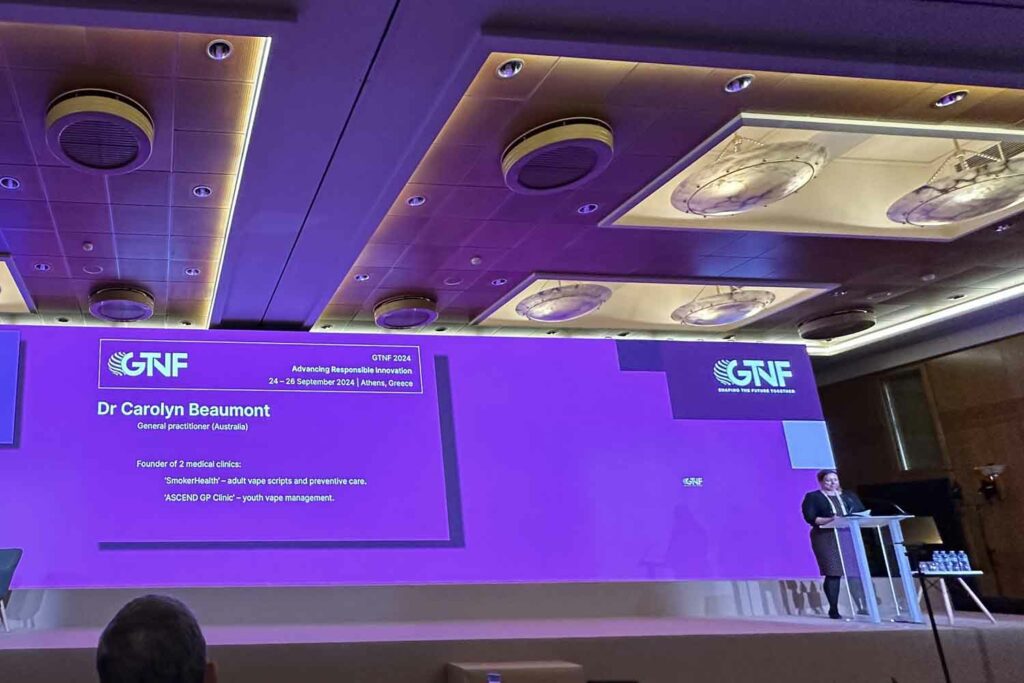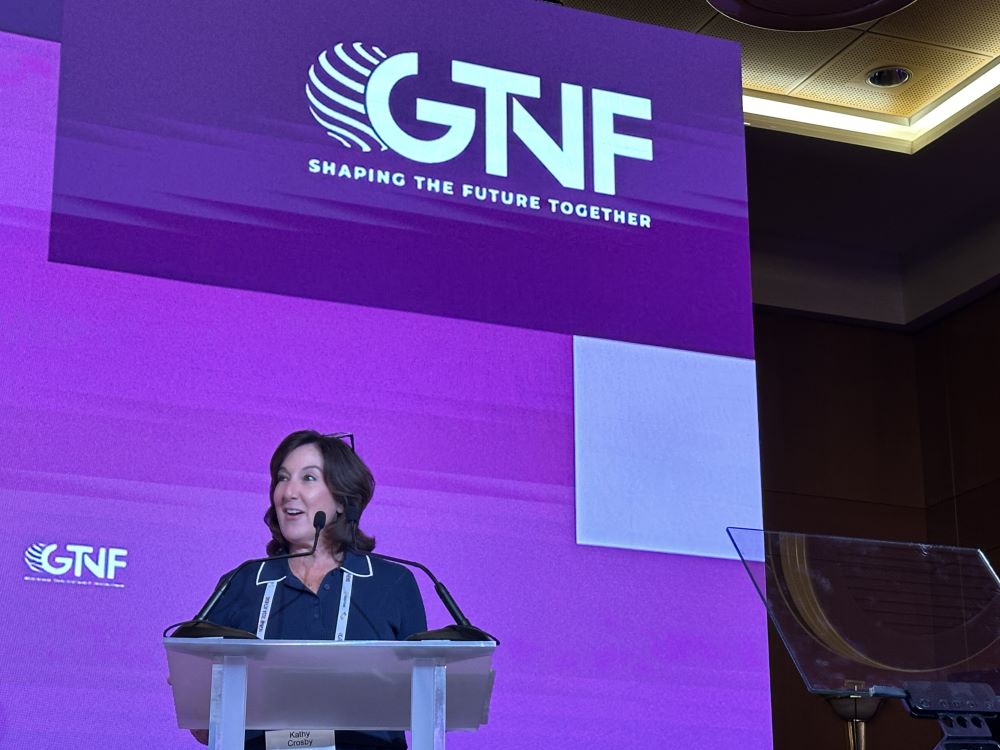
At the recent GTNF in Athens, stakeholders debated how to responsibly advance innovation.
By Taco Tuinstra
For a decade and a half now, the Global Tobacco and Nicotine Forum (GTNF) has nurtured engagement worldwide, fostering lively and constructive discussions among its participants. The GTNF’s most recent gathering, Sept. 24–26 in Athens, was no exception. For three days, the Divani Apollon Hotel served as a modern-day Greek agora, the ancient public space where people exchanged ideas and engaged in philosophical discussions with both friends and adversaries. Paying tribute to the host nation’s famous philosophers, the GTNF delegates asked probing questions, contemplated opposing viewpoints and displayed the courage to doubt themselves.
But even as Athens upheld the tradition of spirited discourse, one of the conference’s most powerful moments was strikingly quiet. On day three of the forum, Carolyn Beaumont, a general practitioner and tobacco harm reduction educator from Australia, concluded her presentation with silence. She then chimed a bell every time a person would have succumbed to tobacco-related disease during that time span. Mindful of the conference’s full agenda, Beaumont played the recording for only a brief period. Had she let it run for the duration of the one-hour panel discussion she took part in, the bell would have tolled 900 times. That’s the equivalent of one death every four seconds, or 8 million deaths—nearly the population of Switzerland—every year.
The staggering numbers underlined the urgency for the industry to help reduce the harm inflicted by smoking, and how to best achieve that goal was a major focus of this year’s GTNF. The task, of course, is formidable. Smoking is a notoriously difficult habit to kick, witness the fact that 60 years after the U.S. Surgeon General’s landmark report on smoking and health, and following decades of anti-smoking campaigns around the globe, more than 1 billion people continue to light up.
Much of that is due to the properties of nicotine. The chemical’s uncanny ability to simultaneously stimulate and relax keeps many users coming back despite the widely known health risks of smoking. Illustrating the tenacity of nicotine addiction, another GTNF speaker, the cardio-endocrine physician Rohan Savio Sequeira, shared an anecdote of a patient who woke up from bypass surgery and immediately asked for a cigarette. “That’s the challenge we’re up against,” Sequeira said.

But while addictive, nicotine is not the compound that causes the most serious smoking-related diseases. Nicotine may elevate blood pressure and heart rate, but the more significant risks presented by cigarettes, including cancer and chronic obstructive pulmonary disease, stem from combustion. Several GTNF speakers compared the rewards and risks presented by nicotine to those of caffeine. But unlike the most popular method for taking caffeine—drinking coffee—the most common nicotine consumption method—setting fire to dried tobacco leaves and inhaling the smoke—exposes its user to thousands of harmful chemicals.
While the obvious solution would seem to be for smokers to consume only the nicotine, through patches, for example, the low success rate of nicotine-replacement therapies in cessation suggests there are additional factors that keep people reaching for cigarettes. As multiple speakers pointed out during the GTNF, smoking is about more than self-administering nicotine. Many aspects of the ritual are difficult to replicate. “Pouch and blow me a smoke ring,” Rae Maile, managing director of research at the U.K. investment bank Panmure Liberum, challenged his intellectual sparring partner, Erik Bloomquist, during a GTNF “fireside chat” about the financial side of the nicotine business.
But innovation is changing the equation. Over the past decade or so, breakthroughs in battery and atomization technologies have allowed manufacturers to construct devices that not only deliver nicotine without the harmful products of combustion but also closely mimic aspects of smoking that many consumers find so appealing—the “throat hit,” the hand-to-mouth motion and, yes, even the ability to blow rings. BAT Group Head of Global Policy Flora Okereke likened the nicotine business’ rapid technological leap to the progress that had played out over a much longer timespan in the automobile business: from Ford’s Model-T to today’s self-driving cars. While not risk-free, these tools, which include e-cigarettes and devices that heat rather than burn tobacco, offer an opportunity to satisfy people’s cravings at a fraction of the risk presented by traditional cigarettes. In 2015, Public Health England memorably announced that vaping was 95 percent less risky than smoking.
Yet despite their considerable potential, such next-generation nicotine products have not been universally welcomed, with many regulators and health groups, including the influential World Health Organization, more attuned to the risk of attracting new nicotine users than the promise of transitioning adult smokers from deadly cigarettes to less risky consumption tools. Electronic nicotine-delivery systems have also come under fire for generating e-waste and creating fire hazards.

Much of the Athens GTNF revolved around this conundrum: How can society reap the benefits of cigarette alternatives without attracting consumers who shouldn’t be using those products and without creating other unintended side effects, such as environmental pollution? As suggested by the 2024 conference theme, at least part of the answer lies in “Advancing Responsible Innovation.”
Acknowledging the fact that tackling the challenges will require the involvement of stakeholders from all parts of society, the conference hosted a whopping 79 speakers, including 30 women, from various professional walks of life. In addition to industry officials, regulators and analysts, the lineup featured health activists, politicians and consumer advocates. There were returning headliners such as the director of the U.S. Food and Drug Administration’s Center for Tobacco Products, Brian King, and numerous first-time contributors, such as Greek Health Minister Adonis Georgiadis, who in a video message encouraged delegates to educate governments so that they could provide their citizens with accurate information about the relative risks of nicotine products.
Other participating politicians included Morgana Daniele, a member of Lithuania’s Parliament and chair of that nation’s Commission for Addiction Prevention, and Pietro Fiocchi, a member of the European Parliament and vice-chair of the Committee on the Environment, Public Health and Food Safety. The retail sector was represented by Henry Armour, president and CEO of NACS in the U.S., and Panos Panayiotopoulos, general manager and director of the Greek retail association, among other speakers.

Perhaps the GTNF’s biggest “coup” this year was the participation of Kathy Crosby, president and CEO of The Truth Initiative, a U.S. anti-tobacco group established after the 1998 landmark Master Settlement Agreement between leading tobacco companies and American states seeking to recover the cost of treating sick smokers. The Truth Initiative has been highly skeptical of e-cigarettes, especially because of their uptake by underage consumers. But Crosby courageously elected to engage rather than demonize the industry—a decision that will surely have raised eyebrows among the more uncompromising members of the public health establishment.
Yet Crosby did not dilute her message. Even as she acknowledged the need for less harmful solutions for smokers who are not ready to leave nicotine behind, she was adamant such products should leave behind their youth appeal. With unauthorized sales accounting for the overwhelming majority of U.S. e-cigarette sales, she urged retailers to remove illegal products from their store shelves immediately. Doing so, she said, would create goodwill and pave the way for constructive dialogue with the public health community. Industry representatives at the GTNF eagerly accepted the olive branch. “The ball is now in our court,” said Jose Luis Murillo, chief regulatory advisor to Juul Labs’ CEO.
Encouragingly, each link of the supply chain represented at GTNF appeared eager to address underage access. While preventing sales to minors is a legal requirement in many markets, NACS’ chief, Armour, stressed that his organization’s members are motivated not by fear of penalties but because they feel a responsibility toward the communities they serve.
Of course, that doesn’t mean it’s easy. Sketching the size of challenge, Armour noted that half of the U.S. population—some 165 people—comes to a convenience store every day, with 40 percent of their inventory comprising age-restricted products such as tobacco, alcohol and lottery tickets. Fortunately, technology, such as digital age verification platforms, are increasingly alleviating the burden.
While the desire to prevent youth access is widely shared among stakeholders, opinions differ on the best way to achieve that objective. Around the world, lawmakers are increasingly resorting to prohibition, banning vape flavors or single-use products, for example—or outlawing new nicotine products altogether.
That is not the approach favored by most GTNF speakers. Counterfactual Director Clive Bates reminded his audience that people have been using nicotine for at least 12,000 years. “Demand will persist because nicotine provides psychoactive rewards,” he predicted. Banning it, Bates noted, will simply shift demand from legitimate suppliers to law-evading ones, as happened in the U.S., where an onerous product authorization system combined with halfhearted enforcement has handed nearly the entire vaping business to the black market. Dave Dobbins, former chief operating officer of the American Legacy Foundation and now a consultant to Altria Group, cited the example of Bhutan, which in 2004 declared a nationwide ban on sales of tobacco products but was later forced to abandon its experiment under pressure from the illicit market (see “Bhutan’s Tryst with Health Imperialism,” Tobacco Reporter, June 2024).
Instead of betting on unworkable bans, many GTNF attendees were hopeful that the same innovation that had brought the world less harmful nicotine products would help tackle challenges such as underage consumption. Elaine Round, group head of life sciences at BAT, took the opportunity introduce the GTNF audience to her company’s recently launched Omni platform, an evidence-based, accessible and dynamic resource that shows how science and innovation can combine to achieve a smokeless world. The potential of such innovations was clearly demonstrated in three “big pitch” presentations, a new GTNF event during which companies outlined their solutions to some of the business’ most vexing problems, and answered questions from an expert panel.

Rhodri James, chief sales officer at Yoti, a digital identity company, described a technology that verifies buyers’ ages by scanning customers’ faces and measuring their skin tone. As people age, James explained, the pigment of their skin changes. Wrinkles, for example, have a different tone than smoother parts of the skin. By determining the differences, Yoti’s technology is able to determine a potential buyer’s age with an almost uncanny accuracy. In tests, the platform performed much better than human store clerks. In addition to speeding up checkouts—and thus reducing “friction” in store transactions—the platform helps defuse what James described as “challenges to the challenge.” Confronted with a customer incensed about being denied a sale, the salesclerk can simply blame the computer. Asked about privacy, James noted that facial age estimation is not facial recognition. The platform, he said, cannot tell who you are—only how old you are.
Greenbutts presented a filter that it claims is biodegradable without compromising performance and taste (see “A Future Without Plastics,” Tobacco Reporter, March 2023). The product addresses a colossal challenge indeed. With 11 billion cigarettes discarded daily, filters are the single most littered item on the planet. As indoor smoking bans have forced consumers outdoors, the problem has only become worse; butts that were previously deposited in ashtrays are now ending up in the environment. Made with cellulose acetate, current filters degrade into nanoplastics, which not only pollute but also end up in the food chain.
Founded in 2010, Greenbutts has developed a plastic-free, plant based product that is 100 percent dissolvable in water. Importantly, the filter delivers the same sensorial experience as cellulose acetate products at a comparable cost, according to the company. In blind tests performed at trade exhibitions, many smokers chose Greenbutt’s filter, said Chief Strategy Officer Luis Sanches, who added that production could be scaled up easily.
Greentank shared a solution that offers vapers a more consistent user experience while lowering the risk of creating undesirable compounds during the heating process. In many currently available vapes, the flavor tends to wane as the pod empties. In tests, the Quantum Vape technology delivered 1,000 puffs with virtually unchanged flavor intensity. According to President and Chief Operating Officer Corey Koffler, Greentank was able to achieve this through “cleanroom chip manufacturing technology combined with physics at nanoscale.” Instead of relying on wicks and coils or ceramics, Quantum Vape comprises thousands of microscopic heating tubes on a chip. The system allows Greentank to precisely control both the location and the duration of the heating, thus eliminating hot spots and avoiding the risk of negative chemical reactions.

The 2024 GTNF highlighted many more examples of such remarkable innovations, which perhaps isn’t surprising considering the amount of money invested. In a discussion among prominent suppliers of vaping hardware, e-liquids and nicotine pouches, company representatives revealed how much their employers spend on research and development. For example, Smoore International Holdings, a leading e-cigarette manufacturer headquartered in China, directs a whopping 10 percent of its revenue to R&D, according to Executive Director Eve Wang.
While celebrating innovation, GTNF speakers lamented the hurdles preventing society from reaping the full benefits of new technologies. Misguided regulation featured prominently among the delegates’ gripes. According to Health Diplomats President Delon Human, 34 countries ban tobacco harm reduction products outright, leaving the market to combustible cigarettes. In the rest of the world, manufacturers must contend with everything from no regulations to very strict frameworks. Many words were devoted to the burdensome product authorization process in the U.S., which has left law-abiding American consumers with only a handful of outdated products and a thriving black market. The European Union’s continuing ban of snus, too, elicited repeated groans, as did the rapid spread of bans on nicotine pouches.
Speakers also despaired at increasing restrictions on vape flavors. Konstantinos Farsalinos, senior researcher at the School of Public Health at the Universities of Patras and West Attica, said that in the name of protecting youth, regulators aimed to make tobacco harm reduction products unpleasant and difficult to access. “But harm reduction will not work if you substitute cigarettes with a product that the smoker does not enjoy,” he warned.
Misinformation was also mentioned as a challenge by many GTNF delegates. The World Economic Forum lists it as the biggest threat to humanity after climate change, noted Tikki Pang, former director of research policy and cooperation at the WHO. In the nicotine business, misinformation is widespread not only among consumers, many of whom now mistakenly believe that vapes are more harmful than cigarettes, but also among people who should know better: doctors. What medical schools teach their students about nicotine is abysmal, noted Jasjit Ahluwalia, a professor of behavioral and social sciences and professor of medicine at the Brown University School of Public Health and Alpert School of Medicine. In a recent survey, 80 percent of U.S. physicians erroneously indicated that nicotine causes cancer. Speakers agreed that education would be key to help correct misperceptions, although they acknowledged that any such effort by nicotine-related companies would likely backfire due to the industry’s enduring reputational challenge.

The Athens GTNF also devoted much attention to a key but often overlooked stakeholder in the debate: the consumer. Nancy Loucas, executive coordinator of the Coalition of Asia Pacific Tobacco Harm Reduction Advocates, emphasized the need to humanize the consumers, who she said are too often treated as mere data points. “We are more than statistics,” said Loucas, after sharing her personal story of transitioning away from smoking with the help of e-cigarettes.
Acknowledging the people that make up the market, tobacco companies appear to be increasingly receptive to that message, as became clear during a keynote by Imperial Brands’ Paola Pocci, whose very title—chief consumer officer—underscores the central role of nicotine users in the manufacturers’ operations. While consumers are similar in their desire for better health, Imperial Brands’ research also revealed that one size does not fit all; they need a variety of product categories to choose from, depending on local regulations and personal preferences, which may vary even depending on the time of day.
To facilitate the transition to lower-risk products, devices must also be easy to use. As multiple panelists observed, innovation is useless if consumers don’t want the product. Bells and whistles that excite product designers also complicate operations, which in turn could deter users. The success of disposables is a case in point. Single-use vapes have become popular largely due to their ease of use; there are no buttons to push, batteries to charge or apps to pair. All the user has to do is puff—just like with a conventional cigarette.
Despite the tremendous technological developments of recent years, GTNF panelists agreed that much work remains. Because no player has yet managed to develop a perfect cigarette substitute, the industry must continue to listen to consumers and address their pain points, said Pocci. The fact that cigarettes are still the most popular nicotine product suggests that the industry has not done enough to reduce the harms of smoking, echoed Marina Murphy, senior director of scientific affairs at the Haypp Group—although she also noted that it had done much better than the pharmaceutical sector, which failed to appreciate that people smoke not only to satisfy their nicotine cravings but also for the sensory aspects.
Even as regulatory frameworks tighten and misinformation persists, the 2024 GTNF once again underlined the industry’s strong commitment to tobacco harm reduction and continued innovation. While the combination of regulatory and societal challenges will keep nicotine companies on their toes, it will also ensure another trove of compelling discussion topics when the GTNF reconvenes at a yet-to-be-announced location in 2025.












